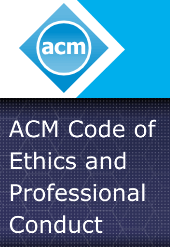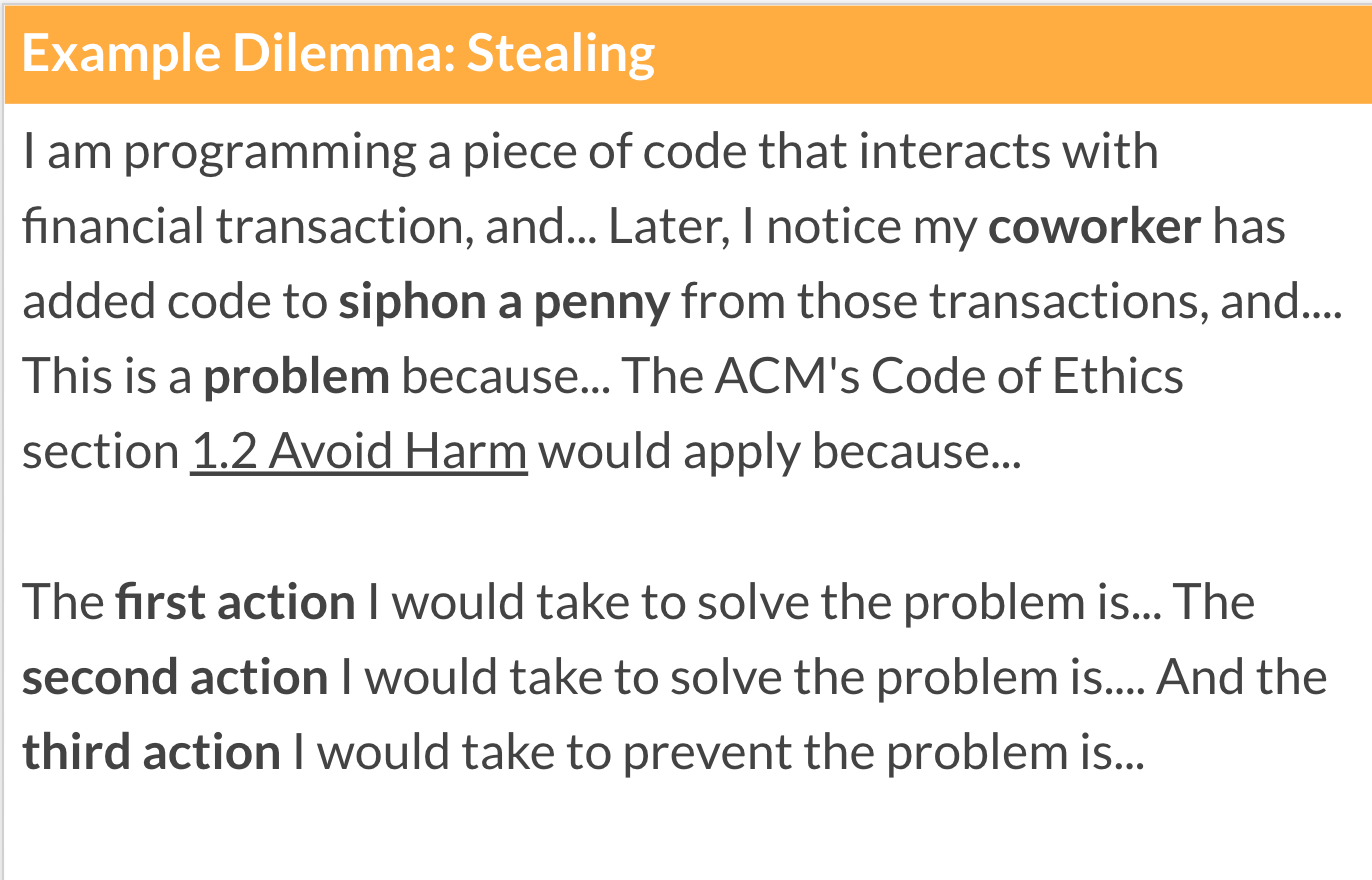Introduction

Ethicisms and Their Risks:
150 new cartoons about ethics at work by Muel Kaptein.
In this chapter, you'll explore the Association for Computing Machinery (ACM) Code of Ethics, how to use it, and how to blow the whistle on a company that is not complying with industry standards and laws. You'll also explore the notion that codes don't work.
Then, you'll examine dilemmas that might present themselves in your future job and devise solutions in relation to the Code of Ethics. You'll base your ideas on the knowledge you've gained throughout the course.
And, if you need extra credit points, synthesize what you've learned from an in-person or online talk and post about it in discussion.
The Association for Computing Machinery (ACM)

Reading List
- ACM Code of Ethics and Professional Conduct.
- Responsible Vulnerability Disclosure in the Ask an Ethicist article.
- Is gray-hat hacking ethical (or even legal)...
After the initial reading, do you think the codes are useful? Would you and your collegues adhere to them? Some experts believe that many people won't adhere to them...read about some of the reasons why:
- Codes of ethics probably don’t work.
- Ethics Training is Broken. Can Storytelling Fix It?
-
Ethical codes vs. ethical code This is why ethical standards don’t work, and what we can do instead.
Or An ethical code can’t be about ethics. - The hidden risk of ethics regulation.
Whistleblowing
If your colleagues aren't adhering to their company and/or professional codes of ethics, what can you do to ensure privacy, security, and safety of your constituents? Telling someone in authority (whistleblowing) might be a consequence that you must partake in. The following resources provide whistleblowing services for different situations:
Reading List
Refer to writing instructions under each page of the template provided in step 8.4.2. Open articles in new tabs and add them to your bibliography tool.
- Americans with Disabilities Act (ADA) Complaint
- Antitrust Violation (FTC) reporting
- Association for Computing Machinery (ACM) Enforcement Procedures
- Copyright Infringement and Remedies
- Equal Employment Opportunity Commission (EEOC) File a Charge of Discrimination
- Federal Bureau of Investigation (FBI) Scams and Crimes reporting
- Federal Communications Commission (FCC) Consumer Complaint Center.
- Computer Emergency Readiness Team (US-CERT) Report Incidents, Phishing, Malware, or Vulnerabilities.
- Electronic Communications Privacy Act (ECPA) Reporting
- Family Educational Rights and Privacy Act (FERPA) File a Complaint
- Health Insurance Portability and Accountability Act (HIPAA) Filing a Complaint
- Institute of Electrical and Electronics Engineers (IEEE) Legal and Compliance
- Justice Department Reporting Computer, Internet-related, or Intellectual Property Crime
- Occupational Safety and Health Administration (OSHA) File a Health and Safety Complaint (OSHA)
- Whistleblower Protection Programs (USA)
- Bureau of Cyberspace and Digital Policy (USA; website to come in 2022)
Role play
Imagine for the next few hours that you have landed your dream job... the job you are seeking a degree for... the job that will fulfill your personal, professional, and financial goals.
Once you see that job in your mind, determine what is required get that job. You may need to research the position prerequisites.
Next, ask yourself... what computer science-related problems could arise in that job and how might you prevent or solve those problems? Do the dilemmas about what to do create extreme concern for your privacy and safety? Refer to the list of concepts, laws, and organizations, below, that could come into play in that position. (Do you remember reading about them in the previous 7 weeks? It is a comprehensive list of the content of this course.)
Software
- Operating Systems and Object-Oriented Programming (OOP)
- Machine Learning and Artificial Intelligence
- Crowdsourcing, cloud computing, and local Computing
- Blockchain
- Computer fraud, computer crime, cyber attack, and cyber-terrorism
- White, gray, and black hat hacking
- Data Leaks, breaches, compromised web pages, outdated software, and browser hijacking
- Ransomware, Spyware, Spear phishing, and Whaling
- Viruses, Trojans, Worms, and Fileless Malware
- Distributed Denial of Service (DDoS)
Hardware
- Linear versus Circular Design
- Mining of raw materials and precious metals
- Radiofrequency and electromagnetic abuses
- Safety violations and poor working conditions
- Alien workforce
- Automation taking low-wage jobs
- Electronic waste
Advertising, Search, News
- Fake News, 'Informational Dominance', and media bias
- Click Bait, Engagement Bait, Click Fraud Malware
- Endorsements and Testimonials
- Email advertising, Spam, CAN-SPAM Act
- Search ads and Adwords
- Opt-in and Opt-out
- Affiliate Marketing
- Truth in Advertising Laws
- Cyberpsychology
- Third-party data mining
- Analytics and 'behavior microtargeting'
Access, Equality, Infrastructure
- Communications services such as WiFi, Internet, electricity, satellite, and/or phone services
- Censorship
- Net neutrality
- Digital divide
- Mobile justice
- Algorithms biased against gender, race, age, class, ability, etc.
- Excessive corporate profits and use of power
- Equal Opportunity Employer, Affirmative Action, or Americans with Disabilities Act accommodations (ADA)
- Fair Chance Ordinance, Veterans Preference, or E-Verify
- Pay Transparency Nondiscrimination Provision
- Internship, Apprenticeship, and Unions
Intellectual Property, Abuse, and Privacy laws
- Patents
- Trade Secrets
- Trademarks
- Copyrights
- Plagiarism
- Educational privacy (FERPA)
- Medical privacy (HIPAA)
- Business privacy (ECPA)
- Finance privacy (Gramm-Leach-Bliley Act)
- The Privacy Act of 1974, search and seizure, third-party data rights
- PATRIOT Act
- Computer Fraud And Abuse Act
The Study of Ethics and Standards
- Act or Rule Utilitarianism, or the Utilitarian Approach
- Kantianism
- Virtue Ethics or the Virtue Approach
- Social Contract theory (Contractarianism)
- The Rights Approach
- The Fairness or Justice Approach
- The Common Good Approach
- Association for Computing Machinery (ACM) Standards and Code of Ethics
- National Institute of Standards and Technology (NIST)
- Institute of Electrical and Electronics Engineers (IEEE)
- International Standards Organization (ISO)
- World Wide Web Consortium (W3)
- EMV Company (EMVCo)
- National Institute of Standards and Technology (NIST)
- SANS Programs to mitigate cybersecurity problems.
- (ISC)² Certified Information Systems Security Professional (CISSP)
- CyberOregon
Example
Students will complete the assignment on their own copy of the provided template, rather than in collaboration.
Use the following template link to complete this research and writing assignment.
- Login to your OSU Google Account.
- Launch this chapter's Explore Topics Template.
- Do not request permission to use the file. Login to your OSU Google Account.
- Once you have the file open:

Example dilemma page, complete with role-played scenario, reference to an ACM clause and number, and three steps to prevent or solve the problem. - File → Make a copy.
- Rename the new file so it includes your "First and Last name" in place of "Template".
- Move the file into a folder for this course.
- Add the job title you seek to the top of the cover page.
- Add your name to the cover page.
- Read instructions on the cover page. When in doubt about how to write in the templates, refer back to this page for clarification.
- Refer to the green instructions below each page to understand what is required.
- Feel free to refer to previous Explore Topics and Examine Cases assignments for ideas and references. To help you make decisions, refer to Santa Clara University's Markkula Center for Applied Ethics Making Decisions flyer and the the Chapter 8 Readings in the previous tabs.
- The last page requires a bibliography.